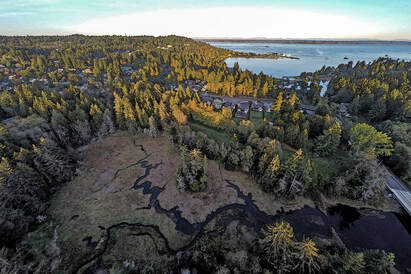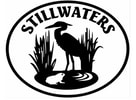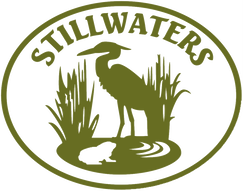
Stillwaters Environmental Center is in Kingston, WA, on the Kitsap Peninsula. We are dedicated to informing and empowering our community to make ecologically responsible decisions.
We assist people to achieve sustainability of Earth’s resources – including both humans and our natural environment.
We use our Carpenter Creek watershed to teach about the many interactions between the plants, animals and humans that inhabit any ecosystem.
We foster action by being a model of sustainability.
We assist people to achieve sustainability of Earth’s resources – including both humans and our natural environment.
We use our Carpenter Creek watershed to teach about the many interactions between the plants, animals and humans that inhabit any ecosystem.
We foster action by being a model of sustainability.
History of Stillwaters
Founded in 1999, by Naomi Maasberg, Joleen Palmer, and a small dedicated board, Stillwaters is situated on nine acres of forested, freshwater wetlands and emergent salt marsh along Carpenter Creek, in Kingston. The Stillwaters’ properties are surrounded by over 200 acres of preserved habitat, owned or protected by Kitsap County, Great Peninsula Conservancy, or the North Kitsap School District.
Since its inception, Stillwaters has been utilizing its inspiring natural setting to empower our community to make ecologically responsible decisions for the health of Puget Sound. Our educational and advocacy influence is amazingly broad for the size of our organization.
Our largest accomplishment is that we proudly worked with Kitsap County and State salmon recovery agencies to replace the two undersized culverts on South and West Kingston Roads as part of the Carpenter Creek Estuary Restoration. Our relentless work on this project since 2000 was honored by naming the first completed bridge the "Stillwaters Fish Passage." Our staff has been honored by Rep. Jay Inslee & by Washington Department of Fish & Wildlife for our work on this salmon recovery project.
A major focus of our work, now and into the future, rests on the fact that Stillwaters is responsible for the pre- and post- habitat monitoring for both bridge construction projects.
The Stillwaters Monitoring Program is critical for the restoration project, but it is also an excellent, active education for university interns, the citizen scientist volunteers, and the community. Our monitoring program has been featured at region-wide conferences as a model for citizen science and community-based restoration monitoring. We are very pleased that the monitoring program can be utilized for field placements and internships for university students from WWU – Huxley College of the Environment on the Peninsulas, and the U.W. Program of the Environment.
As in all our work in the past and the future, we continue our two-pronged approach: we will use the restoration and monitoring program as environmental education, while we, in turn, use education to protect our natural environment.
Since its inception, Stillwaters has been utilizing its inspiring natural setting to empower our community to make ecologically responsible decisions for the health of Puget Sound. Our educational and advocacy influence is amazingly broad for the size of our organization.
Our largest accomplishment is that we proudly worked with Kitsap County and State salmon recovery agencies to replace the two undersized culverts on South and West Kingston Roads as part of the Carpenter Creek Estuary Restoration. Our relentless work on this project since 2000 was honored by naming the first completed bridge the "Stillwaters Fish Passage." Our staff has been honored by Rep. Jay Inslee & by Washington Department of Fish & Wildlife for our work on this salmon recovery project.
A major focus of our work, now and into the future, rests on the fact that Stillwaters is responsible for the pre- and post- habitat monitoring for both bridge construction projects.
The Stillwaters Monitoring Program is critical for the restoration project, but it is also an excellent, active education for university interns, the citizen scientist volunteers, and the community. Our monitoring program has been featured at region-wide conferences as a model for citizen science and community-based restoration monitoring. We are very pleased that the monitoring program can be utilized for field placements and internships for university students from WWU – Huxley College of the Environment on the Peninsulas, and the U.W. Program of the Environment.
As in all our work in the past and the future, we continue our two-pronged approach: we will use the restoration and monitoring program as environmental education, while we, in turn, use education to protect our natural environment.
The Story in Video
These videos tell the story of our work here at Stillwaters. Click Here to watch videos on PledgeTV.
Stillwaters Is...
|
A View From Above
|

